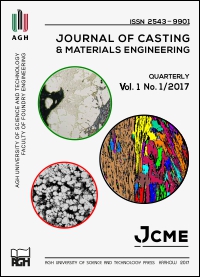Manufacturing Methods of Alloy Layers on Casting Surfaces
DOI:
https://doi.org/10.7494/jcme.2017.1.1.2Abstract
In this paper, we presented the technology of layered castings based on the founding method of layer coating directly in the cast process known as the method of mold cavity preparation by monolithic or granular material of insert. Prepared castings consist of two fundamental parts: the base part and working part (layer). The base part of a layered casting is usually typical foundry material (i.e., pearlitic grey cast iron with flake graphite or ferritic-pearlitic carbon cast steel), whereas the dependence of an insert type (i.e., monolithic or granular) working part (layer) is suitably plated with ferritic and austenitic alloy steels or a layer from a Cr-base alloy. The ratio of thickness between the base and working part is between 8:1 and 10:1. The quality of the layered castings was evaluated on the basis of ultrasonic non-destructive testing, structure, and selected usable property research. According to work out technology, the prepared layered castings can work in conditions that require high heat resistance and/or corrosion resistance from the working surface layer of an element in a medium of industrial water, for example. Moreover, in the case of applying an insert based on Cr-base alloy powder on the working surface layer, it is possible to obtain high hardness and abrasive wear resistance.
Downloads
References
Žic S., Džambas I. & Konić M. (2009). Possibilities of implementing bimetallic Hammer castings in crushing industries. Metalurgija, 48(1), 51–54.
Xiao X., Ye S., Yin W., Zhou X. & Xue Q. (2012). High Cr white cast iron/carbon steel bimetal liner by lost foam casting with liquid-liquid composite process. China Foundry, 9(2), 136–142.
Ike H., Shobuzawa Y., Goto S., Aso S. & Konisi N. (2002). The effect of insert of WC powder on the surface hardening of non magnetic foundry materials. International Journal of the Society of Materials Engineering for Resources, 10(1), 75–80. doi.org/10.5188/ijsmer.10.75
Okada K., Idetsu S., Goto S., Aso S. & Komatu Y. (2002). Surface hardening of some cast irons with inserted hard alloy particles. International Journal of the Society of Materials Engineering for Resources, 10(1), 93–98. doi.org/10.5188/ijsmer.10.93
Zhou R., Jiang Y. & Lu D. (2003). The effect of volume fraction of WC particles on erosion resistance of WC reinforced iron matrix surface composites. Wear, 255, 134–138. dx.doi.org/10.1016/S0043-1648(03)00290-4
Szajnar J., Wróbel P. & Wróbel T. (2008). Model castings with composite surface layer – application. Archives of Foundry Engineering, 8(3), 105–110.
Fraś E., Olejnik E., Janas A. & Kolbus A. (2010). The morphology of TiC carbides produced in surface layers of carbon steel castings. Archives of Foundry Engineering, 10(4), 39–42.
Szajnar J., Walasek A. & Baron C. (2013). Tribological and corrosive properties of the parts of machines with surface alloy layer. Archives of Metallurgy and Materials, 58(3), 931–936. doi.org/10.2478/amm-2013-0104
Szajnar J., Dulska A., Wróbel T. & Suchoń J. (2014). Diffusion of C and Cr during creation of surface layer on cast steel casting. Archives of Metallurgy and Materials, 59(3), 1085–1087. doi.org/10.2478/amm-2014-0186
Heijkoop T. & Sare I. (1989). Cast-bonding – a new process for manufacturing composite wear products. Cast Metals, 2(3), 160–168. doi: 10.1080/09534962.1989.11818997
Zhi X., Han Y., Liu J., Zhao M. & Ma S. (2014). Casting process optimization of a bimetal wear-resistant block using liquid-solid processing. International Journal of Materials Research, 105(10), 953–960. doi: 10.3139/146.111109
Cingi C., Rauta V., Niani E. & Orkas J. (2010). Cast bonding of cast irons to ferritic stainless steel. Materials Science Forum, 654–656, 2712–2715. doi:10.4028/www.scientific.net/MSF.654-656.2712
Arnold B., Heijkoop T., Lloyd P., Rubens G. & Sare I. (1997). Wear of cast-bonded components in a coal pulveriser mill. Wear, 203–204, 663–670. doi: 10.1016/S0043-1648(96)07450-9
Xiong B., Cai C. & Lu B. (2011). Effect of volume ratio of liquid to solid on the interfacial microstructure and mechanical properties of high chromium cast iron and medium carbon steel bimetal. Journal of Alloys and Compounds, 509, 6700–6704. dx.doi.org/10.1016/j.jallcom.2011.03.142
Wróbel T. (2014). Characterization of bimetallic castings with an austenitic working surface layer and an unalloyed cast steel base. Journal of Materials Engineering and Performance, 23(5), 1711–1717. doi: 10.1007/s11665-014-0953-4
Wróbel T. (2016). Layered castings made by method of mould cavity preparation with monolithic insert. Monograph. Gliwice: Archives of Foundry Engineering.
Downloads
Published
Issue
Section
How to Cite
Accepted 2017-01-03
Published 2017-03-17


